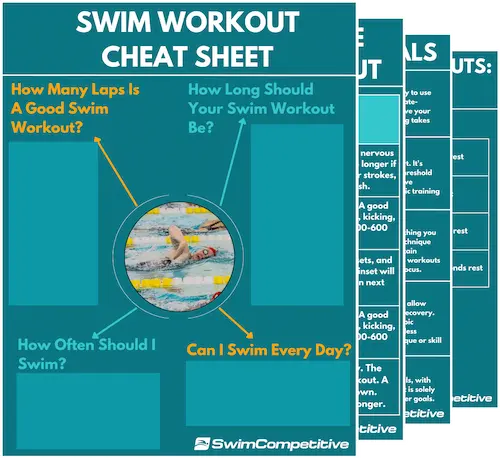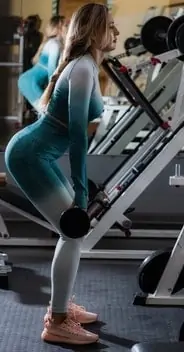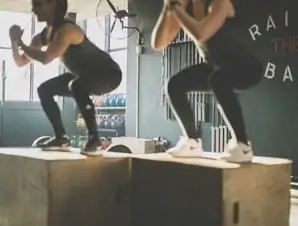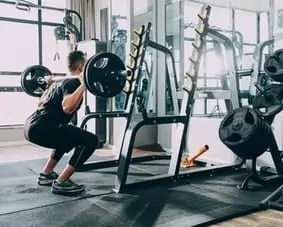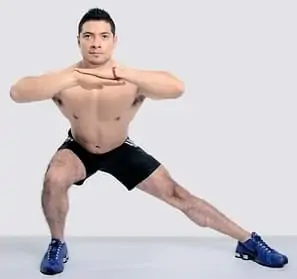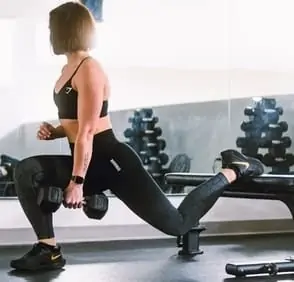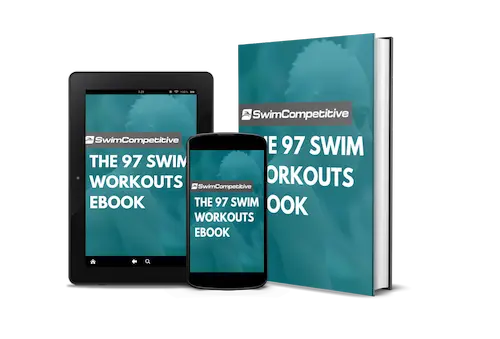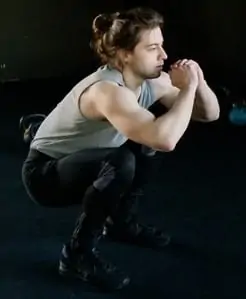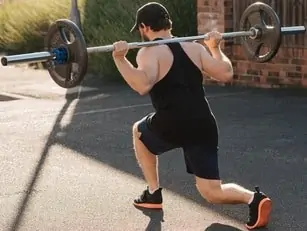When you think of a swimmer’s body, you probably imagine- broad shoulders, big lats, and well-defined abs- but something many overlook is the leg muscles.
Just as the upper body plays an essential role in swimming, so does the lower half. And it’s probably no surprise that in some swimming events, the legs might even be more dominant than the upper body.
So if you want to become a better and faster swimmer, then optimizing your leg muscles’ strength and power is critical.
This is why, in today’s article, we’ll focus on some of the best leg exercises for swimmers to strengthen all of the leg muscles. We’ll also have a quick look at some other aspects, such as the vital role the legs play in swimming.
9 Best Leg Exercises for Swimmers
1. Single-Leg Romanian Deadlift
What The Exercise Does: The single-leg Romanian deadlift primarily strengthens your glutes, hamstrings, calves, and oblique muscles, as well as strengthening a few of your back muscles. The exercise also improves balance and posture while developing a powerful kick and good body position in the pool.
How To Do It: Hold a weight such as a dumbbell or a kettlebell in one or both hands, depending on what you find most comfortable. Then draw your shoulder blades together and down and brace your core.
Next, lift one leg slightly off the floor. While focusing on maintaining a neutral neck position and straight back, bend your hips forward so that your torso moves towards the floor. Your one leg will naturally extend out behind you.
Continue moving towards the floor as far as possible while ensuring your shoulder blades stay back and your chest slightly out. You should feel a nice stretch in your glutes and hamstrings.
Once the weight is hovering just above the floor, start moving back up again. You can briefly touch the floor with your foot to regain balance before going into the next rep. Remember to repeat the exercise on both legs.
Reps And Sets: 8-15 reps per leg for 3-4 sets.
2. Box Jumps
What The Exercise Does: Primarily builds explosive power in the quads, glutes, hamstrings, calves, and core while also adding some strength. Highly important for developing solid starts and push-offs as well as a fast and powerful kick and underwater.
How To Do It: Stand with your feet hip-width apart and face a plyometric box. Brace your core, lower into a half squat, and tilt your upper body slightly forward. As you jump onto the box, make sure to use your arms for momentum and balance.
Start by using a lower box and work towards more height as you become better at the exercise. Make sure to land with both feet simultaneously, and ensure that the entire length of your feet is on the box as you land.
Make it your goal to land as quietly as possible, as it will mean your muscles absorb most of the impact and not your joints.
Reps And Sets: 6-10 reps for 2-3 sets.
3. Back Squats
What The Exercise Does: Strengthens the entire posterior chain, including the glutes, quads, hamstrings, calves, and core. Builds strength and power, ensuring strong kicks, push-offs, underwaters, and starts.
How To Do It: In the squat rack, stand with your feet roughly shoulder-width apart in a comfortable and robust stance. Ensure that your hands are even on both sides of the bar. Take a deep breath, brace your core, lift your chest and unrack the bar.
Then walk 1-2 steps back, and make sure that all your muscles are still tight and braced. Next, squat down until the bottom of your glutes are just below your knees. Afterward, push back up into the starting position and repeat.
Make sure that your back stays straight, and your core braced throughout the entire exercise. Also, ensure that your knee doesn’t move over your toes as you perform the exercise.
I recommend starting with a lighter load or simply with the bar alone while perfecting your technique. Once your form is good, slowly add weight as you get stronger. If you do not have the required equipment, you can try bodyweight squats or goblet squats.
Reps And Sets: 5-12 reps for 3-4 sets.
4. Bodyweight Lateral Lunge
What The Exercise Does: Strengthens the abductors, adductors, quads, hamstrings, glutes, and calves. It also opens up the groin and hip flexors, improving hip rotation vital in swimming, especially in strokes such as breaststroke.
How To Do It: Stand with your feet flat on the ground and wider than shoulder-width apart while keeping your toes pointed forward. Squat onto your one leg, keeping the other leg completely straight and placing the weight on the squatting leg’s midfoot to heel.
Ensure that your butt moves back directly behind your body as with a regular squat and not to the side. Go down as low as you can, but no lower than the standard squatting position. Also, make sure that your knee never goes over your toes.
Once there, push back up into the starting position while ensuring the opposite leg stays completely straight. Repeat for several reps, then switch legs.
If you initially find it hard, try squatting into a chair as you learn the ins-and-outs of the exercise.
Reps And Sets: 8-15 reps each leg for 3-4 sets.
5. Hamstring Curls
What The Exercise Does: Strengthens the hamstrings, glutes, lower back, and hip flexors. These muscles play an essential role in a strong kick and optimal body position in the water.
How To Do It: We’ll be using the physioball hamstring curl, but you are welcome to use the machine variation if you have access to it and prefer it.
The mechanics are very similar- just reversed onto your stomach.
Start the exercise by laying on your back with your heels on an exercise ball. Place your arms next to your sides for support. Activate your core and glutes to lift your lower body off the floor while ensuring your body forms a straight line.
Next, contract your hamstring muscles and bend your knees as you roll the ball with your heels towards your butt. Make sure your hamstrings reach maximum flexion before reversing the movement into the starting position and repeating.
Ensure that the hamstrings are doing most of the work by actively engaging them and keeping your butt high in the air throughout the entire movement. To make the exercise harder, you can perform it with one leg at a time.
Reps And Sets: 12-15 reps for 3-4 sets.
6. Hip Bridge
What The Exercise Does: Strengthens the glutes, hamstrings, and lower back. It also contributes to a better body position in the water, a better upkick, and stronger underwaters.
How To Do It: Start by laying on your back with both feet positioned flat on the floor, roughly hip-width apart. Place your arms by your side for extra support; the further you place them away from your body, the less support they provide and the more balance you have to maintain.
Next, activate your core and glutes as you press down through your heels to lift your hips off the floor. Push your hips into the air until you create a 90-degree bend with your knees, or else just go as high as you find comfortable. Then, slowly lower back down until your hips sit just above the floor and repeat the movement.
As you get stronger, you can make the exercise harder by slightly lifting one foot off the ground and pushing down using only the other leg. Make sure to exercise both legs equally.
If you have the equipment available, you may also opt for the weighted variation of this exercise. Everything stays the same, except now you place your back on a bench while a weighted barbell comes across your hips.
Reps And Sets: 8-15 reps (each leg) for 3-4 sets.
7. Single-Leg Split Squat
What The Exercise Does: Great exercise developing strength and power primarily in the quads and glutes while also engaging the hamstrings, calves, adductors, and core muscles. Furthermore, it helps to develop a strong kick, start, and push-offs.
How To Do It: Stand about half a meter (2 feet) in front of a bench facing away from it. You can perform the exercise with only your body weight, or you can hold a dumbbell in each hand to make it harder.
Place one leg behind you with the top of your foot on the bench facing down and pointing directly back. Maintain good posture, pull your shoulders backs, and keep your chest high.
Then brace your core and squat down with the front leg until your back knee is just above the ground. Make sure that your front knee doesn’t go over your toes. Push back up and repeat all your reps on one leg before switching to the other.
Reps And Sets: 8-12 reps for 3-4 sets.
Do You Want to Make Every Lap Count?
Stop wasting your time in the pool feeling lost and doing directionless swim workouts, and start training effectively! Our ebook contains 97 structured and goal-orientated swim workouts to help you become a better, faster, and fitter swimmer. Whether you’re a complete beginner or a seasoned pro, there are a multitude of workouts for every type of swimmer.
8. Jumping Squats
What The Exercise Does: Develops explosive power and strength in the quads, hamstrings, glutes, and calves. Great for developing a good start and push-offs. It also helps to build fast and powerful underwaters.
How To Do It: Place your feet slightly wider than shoulder-width apart with your hands behind your head or locked together and positioned just in front of your chest. Brace your core and squat down until the bottom of your butt is just below the knee joint while ensuring your knees stay behind your toes throughout the movement.
Once you reach the bottom position, jump up vertically as explosively as you can. Make sure to position your feet for landing while you are in the air.
As you land, move back into the squatting position and explode back up again. Repeat this for a few sets. Take care to land softly and gracefully with your muscles absorbing most of the impact.
Reps And Sets: 12-20 reps for 3-4 sets.
9. Forward Walking Lunges
What The Exercise Does: It’s an excellent all-around leg exercise that strengthens the quads, hamstrings, glutes, and calves while working your balance. Additionally, it helps to develop a strong kick.
How To Do It: Stand with good posture while you position your feet roughly shoulder-width apart. You can place your hands on your hips or hold a dumbbell in each to make the exercise more challenging. You may also opt for a barbell if you have access to it.
Next, brace your core and if you’ve opted for dumbbells, make sure to pull your shoulder blades back and down.
Take an exaggerated step of around half a meter (2 feet) forward, then lower your hips until your front leg is parallel to the ground or as far down as you feel comfortable and your back knee is sitting just above the floor. Make sure that your front knee doesn’t go over your toes as you step forward.
Then, step up so that both your legs are next to each other again. From there, step forward with the opposite leg so that it’s now the front leg. Continue alternating with each step until you’ve completed your set.
Reps And Sets: 8-15 reps per leg for 3-4 sets.
Role of the Legs in Swimming
The leg muscles play many critical roles in swimming- more than you might initially think. Let’s have a look at some of them.
Kicking
One of the most prominent and essential roles of the legs in swimming is the kick. Whether you are a sprinter or long-distance swimmer, a fast and robust kick in the water is crucial for achieving maximum speed and performance.
One study published in the BioMed Research Journal found that the leg kick alone contributed to an average of 31% of the generated force for a 30s fully tethered freestyle swim. This might be slightly lower than you would expect. Nevertheless, it’s still a significant contribution to the overall force. And It can have a substantial effect on swimming speed when maximized.
It’s also important to remember that the legs will most likely contribute to a higher percentage of force depending on the stroke and event. Additionally, theye’ll also come into play in things like starts, turns, and underwaters which we’ll cover in a bit.
For example, breaststroke is much more leg dominant than freestyle. In another example- throughout a 200m freestyle, the legs will most likely contribute more overall force when compared to a 50m freestyle.
On the contrary, another study found that legs could sustain a far greater power output than the arms during a simulated swim using isokinetic dry-land ergometry where the legs generated a total average power output of 435 W compared to the 304 W generated by the arms.
Starts
Strong starts have become far more dominant in the modern-day sport of swimming, with some swimmers such as Caeleb Dressel dominating the rest of the field based on his start alone.
The start is very much a whole-body movement and can get technically very complicated as well, but one thing is sure- strong and powerful legs play a significant role in developing a good start that can put you well ahead of the rest of the field.
Push Offs
Being able to implement powerful push-offs after every turn is one sure way to improve your swimming performance. Almost every swimmer can improve their push-offs. Developing power and explosiveness in the legs will ensure that you can push off every wall with maximum force, almost always guaranteeing you a competitive advantage in the water- especially when swimming short course.
Body Position
One of the most technically essential aspects of every swimming stroke is maintaining a good body position while swimming. As with most things in swimming, a good body position will require the whole body’s contribution.
That said, developing strong glutes, hamstrings, and hip flexors will make it easier for you to maintain a high body position in the water with your lower body.
Underwaters
Good underwaters are single-handedly one of the most important aspects of becoming a faster and better swimmer. Top coaches worldwide are implementing various tactics and training techniques to improve their swimmers’ underwaters.
Once again, underwater dolphin kicks consist of a whole-body movement. Still, undoubtedly the legs play an essential role in developing a fast and powerful underwater dolphin kick.
Fun fact: Did you know that the underwater dolphin kick is faster than any of the four swimming strokes?- Granted that you are actually good at underwaters.
Swim Faster with These Leg Exercises for Swimmers
Leg exercises (as with all dryland exercises) are a great way to boost your swimming performance and become a more well-rounded swimmer. Remember to always warm up properly before performing any dryland or strength training workout and use the correct technique for each exercise to avoid injury.
Furthermore, I recommend focusing more on exercises that work the glutes and hamstrings instead of quad-dominant exercises, as swimmers often lack strength in these muscles.
Try to maintain at least a 1:1 ratio between hip-dominant exercises, such as Romanian deadlifts, and knee-dominant exercises, such as squats. That said, a 2:1 ratio may sometimes be preferable, depending on the swimmer.
